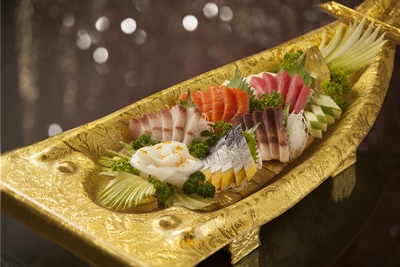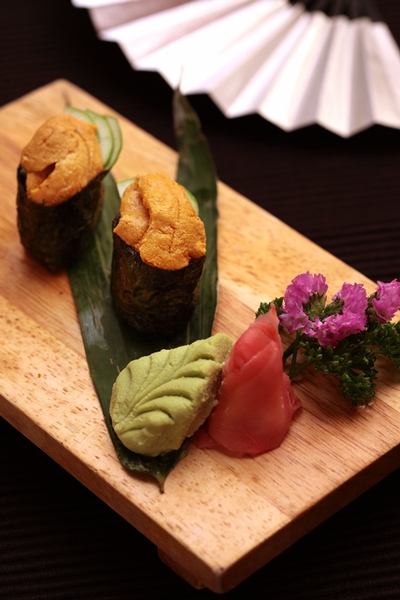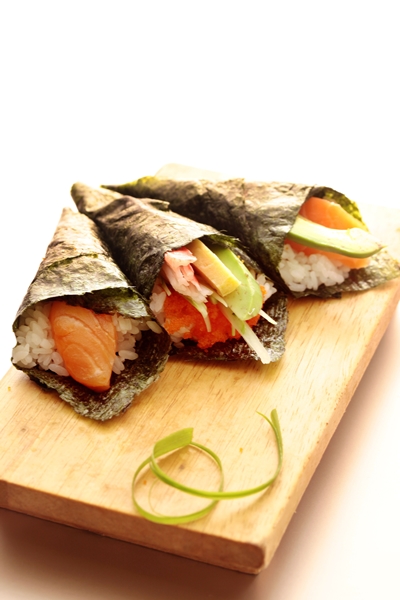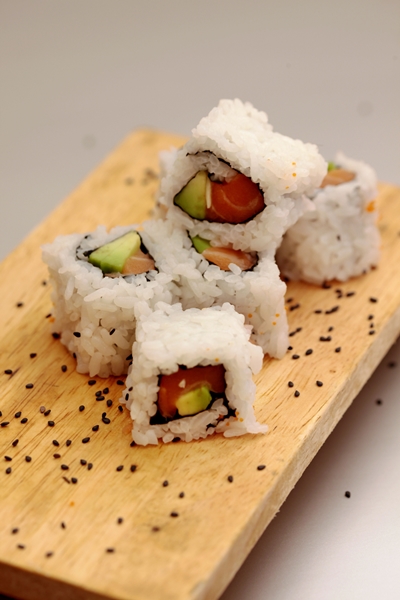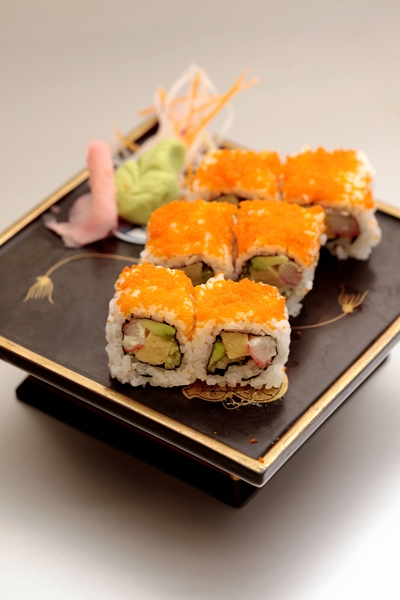Post:CinnamonImage:multiple sources
However, not everyone eats this delicious dish properly like the locals. Travellive sends readers suggestions on how to prepare and eat sushi properly, guided by Japanese chef Kenji Tam (*).
Types of Sushi
Sushi is made from rice, vinegar and other ingredients, most commonly seafood, sometimes with nori (dried seaweed) on the outside and wasabi (mustard) and other sauces. There are many different types of sushi, here are some of the basic types:
+ Nigirizushi: consists of rice hand-formed into a long, rectangular shape with slightly rounded corners and toppings - which can be pieces of raw fish, raw shrimp, raw squid, octopus, or fried egg - placed on top.
+ Aburizushi: includes a portion of rice and a piece of grilled fish placed on top of the rice.
+ Gunkanzushi: includes rice surrounded by seaweed leaves, food placed on top, usually crab eggs, cod eggs, salmon eggs...
+ Makizushi: This is a cylindrical sushi, created by using a bamboo mat to roll the ingredients together into a long cylinder, then using a sharp knife to cut them into shorter pieces (usually cut into 6 or 8 pieces) that are easy to eat. This type of sushi is usually wrapped in a sheet of dried seaweed, sometimes accompanied by a thin omelet, thinly sliced cucumber, and perilla leaves are also used instead of seaweed.
+ Futomakizushi: is a “fat” type of maki, with rice and fillings wrapped inside a sheet of seaweed. The sushi pieces are usually shorter and larger in diameter (5-6cm). The fillings often include a variety of ingredients with different colors or flavors that complement each other.
+ Hosomakizushi: is a “skinny” type of sushi, with rice and fillings rolled inside a sheet of seaweed. The filling is usually just one ingredient, the most common being salmon, tuna, cucumber, carrot, avocado.
+ Temakizushi: this is a cone-shaped sushi with a seaweed sheet rolled on the outside, inside is rice and attractive ingredients rolled exposed on the outside. Temaki is quite large so it must be held and eaten with hands, cannot be picked up with chopsticks. Temaki is usually eaten immediately after wrapping, because the seaweed sheet will quickly become moist and soft, making it difficult for the eater to hold. Therefore, you should note that the pre-made and fastfood-style temaki pieces always have a layer of nylon covering the seaweed sheet, when eating we will pull this nylon piece out.
+ Uramakizushi: this is the type of sushi where the rice is on the outside, the seaweed and fillings are rolled inside. Because the rice is on the outside, to prevent sticking and make it look more beautiful and appetizing, the sushi will be rolled through a layer of fish eggs, shrimp eggs or sesame.
How to enjoy Sushi properly
According to chef Kenji Tam, there are two ways to enjoy sushi: with hands and with chopsticks. Sushi chefs can "taste" with their own talented hands. Every action such as kneading rice, cutting fish or seafood is very careful so that customers can fully feel the flavor in each piece of sushi. Therefore, Japanese chefs encourage diners to use their hands to eat sushi to have the most authentic experience. For the types of sushi with fish or shrimp on the top, we first use the thumb and middle finger to hold, the index finger to place on the body of the sushi, then gently dip the fish in soy sauce and enjoy.
When eating with chopsticks, place the sushi horizontally, use the chopsticks to hold it in the middle and pick it up, turn the sushi upside down, dip the fish in soy sauce and enjoy. Eating this way will help keep your hands clean but it is difficult to dip and pick up the food. In addition, the sushi is wrapped in sticky rice so it can easily fall off when the chopsticks hold it. If you like to eat wasabi, you can put it on top of the fish instead of mixing it with the soy sauce.
Things to do:
+ To fully enjoy the flavors of all types of sushi, you should eat them in order from those with light flavors and light-colored fish (white, silver, red) to those with darker flavors and colors (salmon or salmon eggs).
+ Only dip the top of the seafood into the soy sauce, not the rice. When eating, let the fish touch your tongue first.
+ Eat the sushi as soon as it is served so that the taste, temperature and humidity of the dish do not change.
+ Enjoy the entire piece of sushi at each meal. Do not let the sushi rice fall into the bowl.
+ When enjoying many types of sushi at the same time, you should eat a slice of ginger after each piece to easily enjoy the full flavor of the next types.
+ If the chef does not put wasabi in the sushi, slice the wasabi on a plate and spread it on the surface of the sushi instead of mixing it with the soy sauce.
+ Say "Itadaki masu!" before enjoying the first piece of sushi to show gratitude for the food you are being served.
+ Diners can enjoy sushi with a little sake. After the meal, diners are often served green tea, or roasted tea, to mask the fishy taste of seafood.
+ After finishing your meal, say to the chef: "Gochi-so-sama-deshi-ta." (Wow, what a wonderful sushi party!).
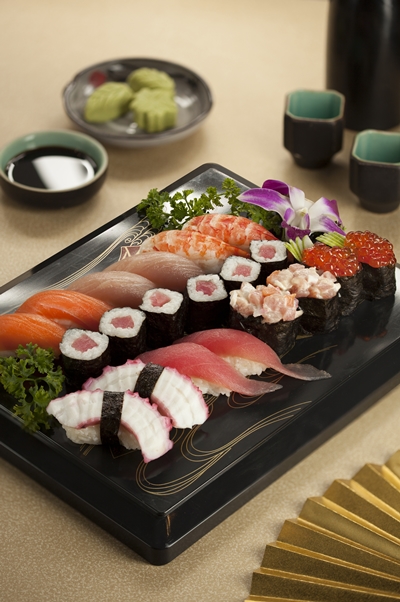
Don'ts:
+ Do not dip the sushi in soy sauce for too long to avoid losing the flavor of the fish.
+ Do not use chopsticks to pierce sushi when eating.
+ Do not pour soy sauce on the sushi.
+ Do not pick up sushi for others with your chopsticks if you have not changed the end of your chopsticks. If you receive sushi from someone else, offer your plate or bowl to receive it, as this shows your respect for the other person. Place your chopsticks on the chopstick holder and place them parallel to the sushi tray so everyone knows you have finished eating.
You can enjoy these sushi dishes at Emperor Restaurant - Fortuna Hotel on weekdays. They are currently introducing "Sushi Festival" with a delicious lunch menu. Price: 420,000 + +VND / 1 adult and 210,000 + +VND / 1 child (under 12 years old). "A very special part of this culinary party is that the chef will make the sushi himself from start to finish" - Chef Kenji said.
Contact in advance by phone: 04. 3831 3333 (Ext: 6461) or by Email: fb@fortuna.vn. Website: www.fortuna.vn
California Roll Sushi (Recipe for 1 serving)
The most famous type of Uramakisuzhi today is the California roll, which is a regular feature on Japanese menus and is especially popular with diners who cannot eat fresh sea fish. California roll with shiny fresh amberjack roe wrapped around the outside and avocado and crab meat filling in the middle will impress you at first sight. The moderate saltiness of salt, the sourness of vinegar, the crispness and sweetness of fresh seafood combined with a little spiciness of wasabi will enhance the stickiness and aroma of Japanese rice.
For a fresh summer menu, you can refer to the recipe below:
Ingredient:
Rice: 200g / Water: 250ml / 1 sheet of seaweed / Vinegar: 1 spoon / Sugar: 1 teaspoon / Bamboo mat: 1 piece / Cucumber: 10g / Omelette: 2 / Crab sticks: 2 sticks / Mayonnaise: 3 gr / Kikkoman soy sauce: 5ml / Shrimp eggs: 5 g / Wasabi mustard: 2 g / Avocado: 1 fruit.
Making:
Wash Japanese rice, put it in a pot to cook. Then take it out and put it in a wooden bowl to fluff it up to cool quickly. Next, pour in vinegar that has been boiled with sugar and stir well to avoid breaking the rice.
Wash cucumber, peel, cut in half lengthwise, remove core, cut into 1cm long pieces.
Thinly omelet, cut into 1cm wide rectangles. Steamed crab sticks. Slice avocado into 1cm wide sticks.
Spread the bamboo mat on the cutting board, cover it with plastic wrap to prevent the rice from sticking to the mat when you turn it upside down and to keep the mat clean for the next rolls. Place the seaweed sheet on top, then put the rice on top of the sheet, spreading it evenly and leaving the top and bottom of the seaweed sheet to avoid the rice from spilling out. Spread the shrimp eggs on the rice. You can also replace the shrimp eggs with sesame or salmon eggs. Turn the seaweed sheet over, put the mayonnaise sauce horizontally on the seaweed sheet, then place the crab sticks, egg strips, cucumber, and avocado sticks.
Roll the bamboo mat to form right angles into a square, roll tightly and smooth across the sushi.
Cut off both ends of the rolled sushi stick and cut the sushi into 8 equal pieces.
(*) Travellive would like to sincerely thank Chef Kenji Tam of Emperor Japanese Restaurant (Fortuna Hotel Hanoi) for supporting this column.

 VI
VI EN
EN



